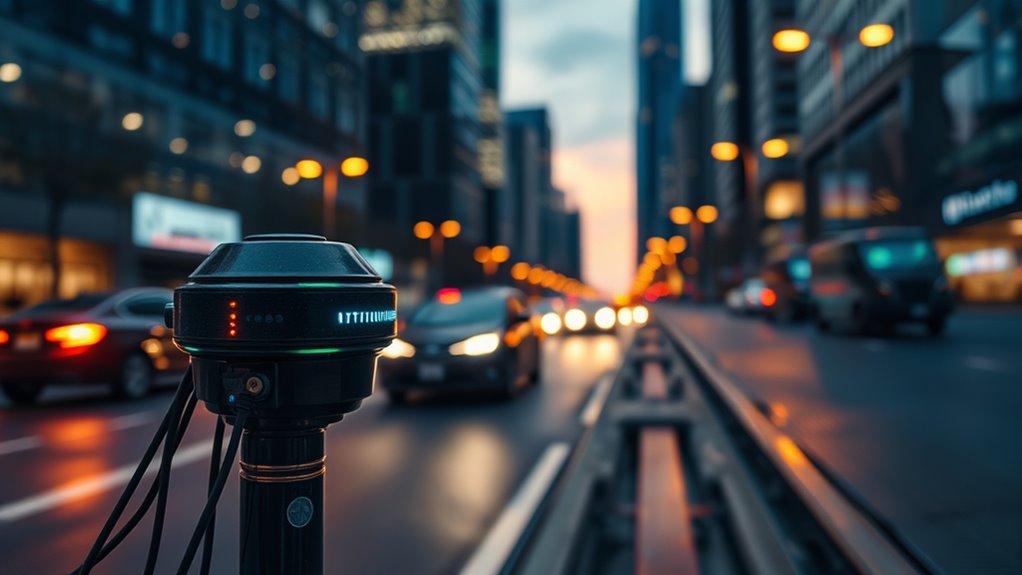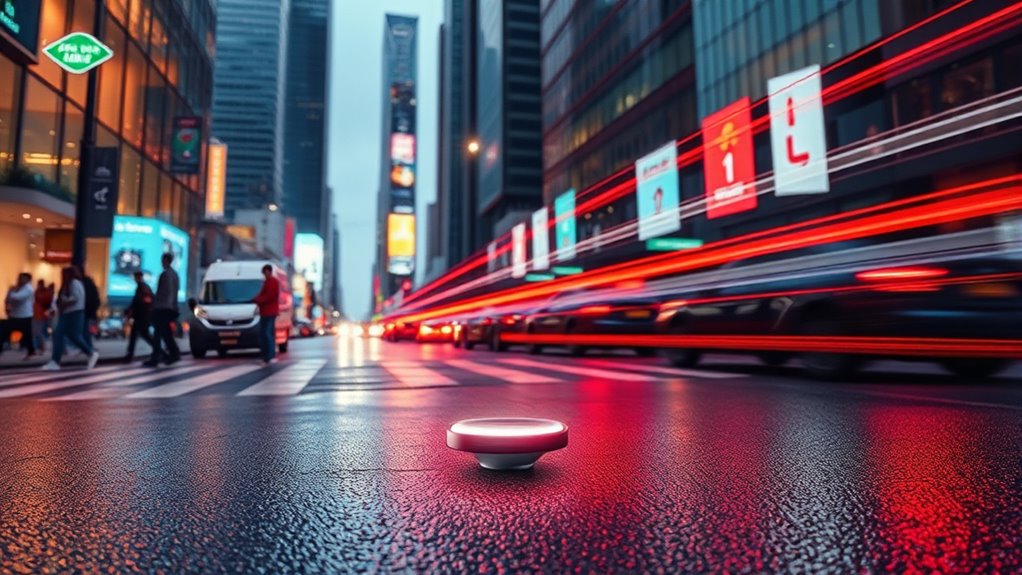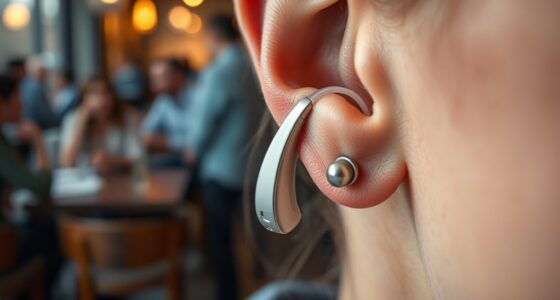Using AI-driven sensors, cities now detect traffic sounds and vibrations in real time. These sensors monitor noise levels along streets and identify disruptions like congestion or construction. AI analyzes the data, then sends alerts to authorities, allowing quick responses such as rerouting traffic or implementing noise controls. This smart system helps create quieter, more responsive urban environments. If you keep exploring, you’ll discover how this technology continues to shape smarter cities for everyone.
Key Takeaways
- AI analyzes sensor data to identify traffic-related vibrations and differentiate them from other urban noise sources.
- Vibration sensors detect traffic sounds and convert them into real-time alerts for city management.
- AI-driven systems classify sound patterns to monitor traffic flow and detect disruptions or congestion.
- Automated alerts enable swift responses, such as traffic rerouting or noise mitigation measures.
- Integrating vibration data enhances urban noise monitoring, promoting quieter, more responsive city environments.

Have you ever wondered how cities can become more responsive to the needs of their residents? “Sensing the City” explores how innovative technologies and data collection are transforming urban environments into smarter, more adaptable spaces. One compelling example is how sensor networks are used to monitor urban noise, turning the cacophony of city life into actionable information. Urban noise isn’t just a nuisance; it impacts health, productivity, and overall quality of life. By deploying a network of sensors throughout the city, authorities can gather real-time data on noise levels across different neighborhoods. These sensors detect variations in sound intensity, frequency, and patterns, providing a detailed map of noise pollution. This infrastructure allows city planners to identify hotspots where noise exceeds acceptable thresholds and implement targeted measures, such as adjusting traffic flow or enforcing quieter zones.
Sensor networks turn urban noise data into actionable insights, helping cities create quieter, healthier environments.
Sensor networks are the backbone of this approach, offering a continuous stream of data that’s both granular and extensive. They are often strategically placed along busy streets, near construction sites, or in residential areas to capture the urban noise landscape. The data collected is processed using AI algorithms that analyze sound vibrations and classify different noise sources—be it traffic, construction, or events. This AI-driven analysis enables the city to distinguish between normal background noise and disruptive levels that require intervention. Instead of relying on sporadic reports or manual surveys, city officials can now respond swiftly to noise complaints, proactively manage traffic to reduce noise, or inform residents about peak noise times. Additionally, integrating multi-source data enhances the accuracy of noise monitoring, allowing for even more targeted and effective responses.
The integration of sensor networks also allows for proactive urban management. For example, if sensors detect a sudden spike in noise levels, an alert can automatically notify traffic control or law enforcement. This real-time response minimizes disturbances and helps maintain a more livable environment. Additionally, data from these sensors can inform long-term urban planning, guiding decisions on where to build sound barriers or reroute traffic. As cities become more connected, this sensor-driven approach to managing urban noise exemplifies how smart technology can enhance responsiveness and improve residents’ daily lives.
In essence, by harnessing sensor networks to monitor urban noise, cities transform raw sound data into meaningful insights. These insights empower you, as a resident, to enjoy a quieter, healthier environment and foster a city that adapts swiftly to the rhythm of its inhabitants. This innovative use of AI and sensors is just one way that “Sensing the City” is shaping a more intelligent urban future.
Frequently Asked Questions
How Accurate Are Ai-Driven Vibration Sensors in Noisy Urban Environments?
You might wonder how accurate AI-driven vibration sensors are in noisy urban environments. These sensors rely on proper sensor calibration, which helps distinguish true vibrations from background noise. While they’re quite effective, false positives can occur if calibration isn’t maintained or if there’s excessive noise. Regular calibration guarantees better accuracy, reducing false positives, and improving the reliability of alerts even amidst the city’s bustling sounds.
What Types of Alerts Can the System Generate for City Authorities?
You’ll find that AI vibration sensors can generate a variety of alerts for city authorities, with emergency notifications being a top priority. Studies show these systems can detect incidents 30% faster than traditional methods, helping respond promptly. They also support infrastructure monitoring, alerting officials to potential damage or wear. By providing real-time data, these alerts help keep your city safer and more efficient, improving urban living for everyone.
How Does the Technology Differentiate Between Various Traffic-Related Vibrations?
You use advanced sensors that analyze vibration signatures to differentiate traffic-related vibrations. The system compares each vibration signature against a database, identifying patterns unique to vehicles, horns, or construction. Regular sensor calibration guarantees accuracy, helping the system adapt to changing conditions. By distinguishing these signatures, it can accurately identify specific traffic events, enabling timely alerts for city authorities to address issues or manage traffic flow effectively.
What Are the Privacy Implications of Deploying Vibration Sensors in Public Spaces?
You should consider that deploying vibration sensors in public spaces raises significant privacy issues. These sensors collect data that could inadvertently capture personal information, leading to data privacy concerns. Surveillance concerns also increase, as the sensors might be seen as tools for constant monitoring. It’s important to implement strict data management policies and transparency measures to guarantee public trust and protect individuals’ privacy rights.
How Scalable Is This System for Large Metropolitan Areas?
Think of this system as a growing vine wrapping around urban infrastructure. Its scalability depends on how well you can expand sensor deployment across a metropolis without overloading city systems. Large areas require robust infrastructure, data management, and maintenance. With proper planning, technology, and resources, you can extend this vibration sensor network, turning it into a city-wide alert system that adapts seamlessly, much like a vine spreading its reach to cover more ground.
Conclusion
As you walk through the city, imagine its sounds transformed into a vigilant symphony, each vibration a watchful eye. AI-driven sensors turn traffic noises into alert signals, like a nervous heartbeat keeping you safe amid the bustling urban pulse. This technology weaves a digital web, capturing every rumble and roar, ensuring you’re always a step ahead. With vibrations as your silent guardian, the city becomes a living, breathing entity that listens and responds to your safety.











